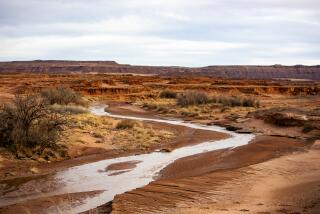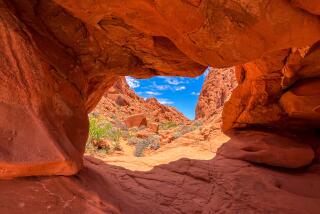Las Vegas’ Thirst for Water Upsets Many in Arid West : Development: Boom town plans 1,000-mile pipeline. Critics say the city should live within its means.
- Share via
LAS VEGAS — Drive west from the famed casino Strip about five miles, past gas stations and convenience stores, until the desert appears by the road. Keep going until the scenery turns to blue lagoons, soft green turf and a sea of tile roofs. This is the new Las Vegas.
On this island of lush suburbia amid the sand and cacti, the country’s fastest-growing big city absorbs new arrivals into its sacred myth. Tracts called Beachport and Shoreline Estates, cul-de-sacs with names such as English Mist Circle, and apartment complexes known as Catalina Shores and Cayman Bay imply a desert somehow awash in water.
The myth of plentiful water ignores a dry truth about Nevada. Less rain and snow fall here than on any state. Las Vegas is running low on water even with the biggest pool on the lower Colorado River, Lake Mead, 18 miles from the gaming tables at Caesars Palace.
They think big in Las Vegas, and they have a grand solution. Officials here want to lay 1,000 miles of pipeline across the desolate valleys of central Nevada, to extract water from an underground cache believed to run from Death Valley to Idaho.
Hatched secretly in the fashion of Western water schemes, the Las Vegas plan has touched off a fury of opposition across the arid West. In upstate Nevada, ranchers and homesteaders talk of being sucked dry by a growth-crazed invader from the south in a repeat of California’s Owens Valley saga.
Scientists for the National Park Service have predicted that the Las Vegas wells could doom Death Valley’s oasis springs. Former Arizona Gov. Bruce Babbitt signed on to help fight the plan, and even the Las Vegas Sun, the afternoon newspaper edited by former Gov. Mike O’Callaghan, has urged restraint.
“Rural Counties Have Valid Worries About Water Grab,” said the headline on a Sun editorial last year.
The heat generated by critics, and the magnitude of the plan, have helped nudge Las Vegas into an unusual re-evaluation of its water use, if not its thirst for that which the rural counties have.
“We had to do it,” said Patricia Mulroy, general manager of the Las Vegas Valley Water District, who cited lack of future water for a recent decision to stop issuing permits for new developments.
With growth expected to continue, Las Vegas could run dry in 15 years, Mulroy said--sooner if residents accustomed to back-yard swimming pools, birdbaths and fruit trees do not begin to accept that they live in a desert.
She calls water conservation an alien concept for most Las Vegans, who the Sun agreed are “notorious for wasting water. Almost every homeowner has a lush Midwest-style lawn that is over-watered each day.”
A recent caller to KDWN radio enunciated the Vegas water ethic, urging public spankings for proponents of a new ban this summer on afternoon lawn watering. “We have water now, let’s enjoy it,” he said. “Where there is water there should be grass.”
Some shift in thinking is under way. “Why does everything have to be green?” KDWN talk show host Ted Bair recently asked his audience, urging them to return their yards to desert plants.
Water rates have been raised to encourage conservation. Low-flow toilets were ordered for the hundreds of homes built every year, and a law that required green landscaping around new neighborhoods was changed.
For the first time, top candidates for mayor in this week’s election are saying the wasteful Las Vegas lifestyle is dated. A ban on artificial lakes proved so popular that one candidate, Councilman Steve Miller, is running radio ads taking credit.
The lake ban was aimed at places similar to Desert Shores, a subdivision of new homes, apartments and boating lakes on the west edge of Las Vegas. “Finish with a splash!” the ads shout for Shoreline Estates, a Desert Shores development on Lake Jacqueline, where the water seems unnaturally blue and the white geese out of place.
Hundreds of new houses are rising this spring on the desert west of old Las Vegas. A 3,100-unit Del Webb’s Sun City is under construction in a 36-square-mile planned community known as Summerlin, which crows that it is America’s Newest Hometown. Summerlin, which plans to house 150,000 people, is going up on land the late billionaire Howard Hughes acquired from the U.S. government in the 1950s, and is named for Hughes’ grandmother.
The outward move of Las Vegas became inexorable last month when Clark County’s commissioners announced that they were moving the county offices from downtown to the western frontier.
South of town, in suburban Henderson, the last and most controversial artificial lake is starting to fill with Colorado River water. When it tops out in 1992, the two-mile-long Lake Las Vegas will expose 320 acres of water to the desert sun. It is part of a $3.8-billion development of hotels, homes and golf courses given permits before new lakes were banned.
The growth is dizzying, but justified by economics. New homes sell long before they are completed. The University of Nevada-Las Vegas said the influx of new residents reached 6,000 a month last year, when Clark County’s population shot to 741,459 from its 1980 level of 463,087.
An astonishing spurt ended the 1980s, as the huge Mirage and Excalibur hotel-casinos opened on the Las Vegas Strip. Water use jumped in two years by 50,000 acre-feet--equal to the increase during the previous nine years. The tide ebbed a bit last year, but still 4,024 homes sold in Clark County--up 24% from the year before--and building permits were issued for 7,311 apartments.
It is new residents, not the waterfalls and fountains outside the big hotel-casinos or the 20 million annual visitors, that tax the water supply, Mulroy said. “The hotels use a small share of the water and provide most of the jobs,” she said. About 65% of Las Vegas water is used by homes, mostly in the yard.
Las Vegas gets most of its water from the Colorado River, with about a fifth coming from wells. Both sources are about tapped out, Mulroy said. Seven states share the Colorado, but Nevada has rights to the least water, and its river allotment is only enough to service the growth anticipated by 2006.
Wells are shutting down because of ground subsidence that began in the 1950s and ‘60s. The Earth has sunk beneath some Las Vegas neighborhoods, cracking foundations and streets. In one startling example, the head of a former well is now stranded five feet in the air.
Las Vegas officials say they considered building a desalination plant on the Southern California coast and trading its output for some of California’s Colorado River water, but rejected the idea as too expensive.
Instead, in late 1989, they took rural counties by surprise and filed 145 claims for “unappropriated” ground water, which in Nevada is a public resource awarded to worthy applicants by the state engineer’s office. The claims totaled 864,195 acre-feet, more water than the city of Los Angeles uses in a year.
The water would come from Nye, Lincoln and White Pine counties--total population 30,820--and rural parts of Clark County. Wells would pump from a carbonate aquifer that geologists think extends northeast from Death Valley.
Mulroy insists that Las Vegas will need less than half the water it filed for to serve a population expected to reach 1.4 million by 2020--more than live in all of Nevada today--but sought more claims than necessary in case some are denied.
Speed and secrecy were justified, Mulroy said, to head off claims by water speculators and Los Angeles, which needs water for a power generating station that it wants in rural Nevada. “This put us first in line,” she said.
Once alerted, ranchers, miners and wilderness activists who usually fight each other lined up to oppose the plan. More than 3,600 protests were lodged with state engineer Mike Turnipseed, including one from the Inyo County Board of Supervisors in California, home of Owens Valley, a symbol of big-city greed to rural supporters.
“We can see what happened in the Owens Valley, it’s not a pretty picture,” said Stephen T. Bradhurst, a former Nye County planning director. Since early this century, the Los Angeles Department of Water and Power has bought 90% of the land in Owens Valley, shipped the water south, and been blamed for squeezing the economic vitality from towns such as Lone Pine and Independence.
Critics say Las Vegas is trying to feed its runaway growth at the rural counties’ expense, rather than imposing tough conservation measures. But they know that in Nevada political fights, Clark County--home to more than half of the state Legislature--usually gets its way. Turnipseed, who held his first hearings last month, is not expected to approve or deny the plan for more than a year.
“This was just the politically easiest thing to do,” said Chris Brown, Las Vegas head of Citizen Alert, a Nevada environmental group. “They knew they had more power than the rural counties.”
Opponents hope to persuade the Bureau of Land Management to deny permission for the pipeline to cross federal land, and to invoke federal environmental laws. The aquifer Las Vegas plans to tap supplies 300 springs in Death Valley National Monument and nearby Ash Meadows, home to the inch-long Devil’s Hole pupfish protected as an endangered species by a 1976 Supreme Court ruling.
“They can change Nevada law, that’s the way they operate,” said Bradhurst. “They cannot change the Endangered Species Act, the Clean Air Act and the Clean Water Act.”
At the first hearings on the plan last month, opposition came also from Las Vegas residents who will pay the $1.95-billion tab. Newcomers and old-timers alike were lukewarm about encouraging more fast growth, calling the existing traffic, air pollution and crime already too much. Murders in Las Vegas were up 18% and rapes up 22% last year.
A sign of frustration, pollsters say, is that many Las Vegans who moved here for the lack of state income and estate taxes would gladly pay new taxes for freeways and roads.
“Too many people,” said attorney Tom Moore last month, lounging at the Mirage Hotel pool the day before his family quit Las Vegas, after a decade, for Georgia.
In the morning Review-Journal, which runs a weekly map warning of traffic “choke points,” a straw poll last August on the rural water plan drew 382 phone calls, 82% opposed to importing water. The paper endorsed the plan in an editorial that drew on accounts of Anasazi Indians vanishing from the local desert a millennium ago because of drought.
If Las Vegas does not get the water, the paper argued, “future archeologists will be asking themselves why that desert city of glass and steel withered and died.”
More to Read
Sign up for Essential California
The most important California stories and recommendations in your inbox every morning.
You may occasionally receive promotional content from the Los Angeles Times.










